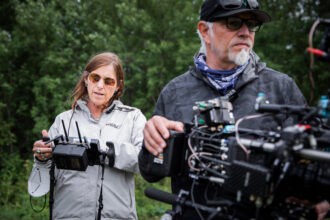Hindered Wildfire Responses, Costlier Agriculture Likely If Trump Dismantles NOAA, Experts Warn
As the Popo Agie river wends its way down from the glaciers atop Wyoming’s Wind River Mountains toward the city of Lander, it flows into a limestone cave and disappears. The formation, known as the Sinks, spits the river back out at another feature called the Rise a quarter of a mile east, a little more voluminous and a little warmer, with brown and rainbow trout weighing as much as 10 pounds mingling in its now smooth pools. The quarter-mile journey from the Sinks to the Rise takes the river two hours.
Scientists first discovered this quirk of the middle fork of the Popo Agie (pronounced puh-po zuh) in 1983 by pouring red dye into the river upstream and waiting for it to resurface. Geologists attribute the river’s mysterious delay to the water passing through exceedingly small crevasses in the rock that slow its flow.
Like many rivers in the arid West, the Popo Agie is an important aquifer. Ranchers, farmers, businesses and recreationists rely on detailed data about it—especially day-to-day streamflow measurements. That’s exactly the type of empirical information collected by the National Oceanic and Atmospheric Administration (NOAA).
Explore the latest news about what’s at stake for the climate during this election season.
Yet this summer, the Heritage Foundation’s Project 2025, which the conservative think tank promoted as a blueprint for a second Trump administration, called for NOAA to be eliminated. And with the election less than a week away and polls showing a gap between Vice President Kamala Harris and former President Donald Trump tight enough to slow the flow of the Popo Agie, the agency’s future could hang in the balance.
In Project 2025’s chapter on NOAA’s parent agency, the Department of Commerce, Thomas Gilman, a senior official in the department during Trump’s first term, wrote that “the National Oceanographic and Atmospheric Administration should be dismantled,” misstating the agency’s name. Many of NOAA’s functions should be eliminated, outsourced to states, moved to other agencies or privatized, he argued, and the National Weather Service, NOAA’s weather forecasting operations, should focus on commercializing its data.
Gilman called NOAA “one of the main drivers of the climate change alarm industry” and singled out its Office of Oceanic and Atmospheric Research to say the “preponderance of its climate-change research should be disbanded.”
Such actions could have severe consequences in the West, experts warn. NOAA’s products “are crucial to everything from agriculture to farming and ranching, and then of course wildfires: wildfire management, wildfire protection, wildfire planning or things like controlled burns,” said Aaron Weiss, deputy director of the Center for Western Priorities, a nonpartisan advocacy group that works to protect Western land, water and communities.
NOAA tracks, studies and maps a vast array of natural phenomena across the globe—including wildfires, drought, hurricanes and space weather. Its data underpins the Centers for Disease Control and Prevention’s heat risk tool and the country’s drought monitoring map. Shipping companies, retail manufacturers, fisheries and insurers rely on NOAA for weather forecasts to predict utility costs and manage financial risk. Airlines and the communication industry count on NOAA to monitor space weather, which can disrupt an aircraft’s navigation system and satellite communications.
“This is a proposal that would lead to people dying.”
— Aaron Weiss, Center for Western Priorities deputy director
The agency has a network of buoys criss-crossing the Earth’s oceans to better understand marine life and predict changes in climate as a result of the warming and cooling patterns of El Nino and La Nina cycles. This June, NOAA conducted test runs of two wildfire identification tools the agency says will be able to “speed fire detection and warning.” There are 330 members of the NOAA Commissioned Officer Corps, one of the country’s seven uniformed services deployed around the country to respond to land and sea emergencies.
The Defense Department leans heavily on NOAA’s Arctic weather forecasts and climate models as part of its developing strategy in the region, Iris Ferguson, the deputy assistant secretary of defense for Arctic and global resilience, said in July. She called that collaboration “vital to U.S. national security” as Russia and China ramp up interest and activity in the Arctic.
Privatizing NOAA’s weather forecasts and eliminating its climate science is “not just a terrible idea,” Weiss said. “It’s a dangerous one.”
“This is a proposal that would lead to people dying,” he said.
The Heritage Foundation did not return multiple requests for comments for this story.
Watching the Water
Many Western communities sit well above sea level or in arid environments, complicating reliable access to water.
“Water is probably the resource of emphasis in our district,” said Dave Morneau, a conservation specialist with the Popo Agie Conservation District in Lander. In the past, the Popo Agie Conservation District has worked with NOAA to install stream gauges on its namesake river, and today Morneau and his organization monitor the waterway with a hodgepodge of federal, state and district equipment.
They send this data from the Popo Agie and snowpack to irrigators to help them determine how much water they should expect through spring; to owners of flood-prone land to assist their preparations for potential deluges; and to recreators like fishermen and rafters to help them figure out the best times to be on or avoid the water.


“Climate data is important for us to understand what kind of snowpack levels we have, drought, temperatures [and to see] what the trends are,” Morneau said, adding that the Popo Agie Conservation District will include links to NOAA data on snowpack and stream forecasts in its newsletters, which go out to ranchers and other local landowners.
“It’s good to have a national-level program where you can look across the country and make correlations,” Morneau said. His conservation district would do the best it could if NOAA were gone, he said, for instance by using the local volunteer network of precipitation gauges. “But that doesn’t mean that we don’t rely on federal and statewide networks,” he said, and losing access to NOAA data “would be concerning.”
Farmers across the West use NOAA to help them decide which crops they should plant.
“We are facing such a drier, more arid future here in the West,” said Ashley House, vice president of strategy and advocacy at Farm Bureau Colorado, a farmers’ advocacy group. Data on streamflows is crucial for navigating those conditions.
House said that farmers in Colorado and other Western states are “largely dependent on science and data collection, and sharing that across geographies and sharing that locally.” Federal climate modeling plays an important role in a farmer’s seasonal planning, too.
“The more predictive we can be with some of the modeling,” she said, “the more we can do to mitigate against flooding” and other natural disasters that harm farmers’ yield, their profit margins and the nation’s crop supply.
Privatizing access to weather forecasts adds “one more cost that a farmer has to pay that really, in my mind, should be available and should be a given for you if you’re going to produce food and fiber in a safe, affordable way for the domestic supply.” It could also potentially raise the price of food by forcing farmers to spend more money on planning and forecasting, she added.
Other agencies track snowpack levels and other climate data in the West, like the U.S. Department of Agriculture, whose National Water and Climate Center offers snow surveys, water supply forecasting and soil monitoring. But while some data from those agencies overlaps with NOAA data, it is gathered with different tools and techniques and can’t replace it.
“All farmers are risk managers,” House said, and they need as many tools as possible to navigate those risks. “At the end of the day, if we have to encounter another hurdle to manage risk on consumers’ behalf, that’s not good.”
Following Fires
NOAA provides public information on environmental conditions that could lead to a wildfire, maintains tools for firefighters as they track and fight blazes and keeps communities that survive wildfires updated on burn zone and weather conditions that could lead to post-fire flooding and debris flows, sometimes deadlier than the fires themselves.
Wildfires in the West have grown larger, hotter, deadlier and more destructive in recent decades, partly as a result of climate change. This month, a team of researchers at the University of Colorado Boulder published a study that found Western wildfires are growing faster, and last year, the Senate’s Joint Economic Committee said wildfires cost the U.S. between $394 billion to $893 billion annually. NOAA estimates that the risk of large wildfires throughout the West could rise by as much as 600 percent in some areas of Montana and Wyoming, and by at least 300 percent in parts of every state in the contiguous U.S. west of Texas in the coming decades.
“This data and having this service is so critical,” said Michele Steinberg, the wildfire division director for the National Fire Protection Association, a global nonprofit that helps communities prevent fires. “If we’re not watching the data from NOAA and other partners, we’re going to get behind wildfires.”

For most of Steinberg’s 25 years in the business, wildfires would usually occur in the West during the fall after snowmelt has been all but depleted and fresh snow has not yet fallen to take its place. “That’s kind of off the board now,” she said. As increasing aridity has expanded Western fire seasons, NOAA’s drought monitoring has been integral to National Fire Protection Association efforts to raise fire risk awareness, and to federal agencies that coordinate fire responses across the country, she said.
NOAA, Steinberg said, “is helping us plan much better.”
Given the role NOAA plays in wildfire management and response, Steinberg found it difficult to imagine scrapping operations that could contribute to those efforts. “When you’re talking about something that is the practice, the way we operate, I would not go into this lightly,” she said. “It is a matter of firefighter safety and health. It’s a matter of civilian safety and health.”
Project 2025 did not mention NOAA’s work with wildfire. Its authors did not respond to questions about whether firefighters and people living in wildfire-prone areas would need to pay for access to wildfire weather information under their privatization proposals.
Partnering with Academia
To execute some of its climate research, NOAA partners with universities across the country. Without those partnerships, “we’d be losing a ton,” said Christine Wiedinmyer, associate director for science at the Cooperative Institute for Research in Environmental Sciences (CIRES) at the University of Colorado Boulder.
Wiedinmyer called the partnership between NOAA and the University of Colorado a “win-win-win” for the agency, students and the people of Colorado because the state’s economy relies so heavily on its environment. Tourism, outdoor recreation, scientific research, farming, forestry, transportation and other economic sectors all rely on environmental data and are all integral to the state’s prosperity. Colorado has more than 46,000 agriculture jobs alone, according to state data from 2022.
“We employ a lot of people through this cooperative agreement,” Wiedinmyer said. If funding for such partnerships dried up, “we’d have a huge loss of employment for a lot of people.”
Being able to predict streamflow, monitor snowpack, track drought and respond to wildfires has “huge impacts across the entire West,” Wiedinmyer said. “NOAA is key to providing us observations and data and predictions on this so that we can best manage our resources and our air quality, and best protect human health and livelihood.
“There’s so much that NOAA science contributes to regarding the well-being of the West.”
Wiedinmyer pointed to similar benefits arising from partnerships NOAA has elsewhere in the West, including cooperative agreements with universities in Alaska, Arizona, California, Hawaii, Oregon and Washington, as well as Midwestern and Eastern states.
Perils of Privatization
Weiss, with the Center for Western Priorities, said he was particularly concerned about how privatizing weather forecasts and eliminating climate modeling could negatively impact rural communities in the West. Wyoming, Montana and Idaho are some of the country’s least populated places, and under a private weather forecasting model in which profit is a company’s primary motive, there is no guarantee such sparsely populated areas would receive quality, timely predictions.
At NOAA, “the amount of attention that goes into a National Weather Service forecast for 10,000 to 20,000 people who might need it for a field office in Wyoming is going to be the same amount of attention that goes into what’s needed for a field office in Los Angeles or New York. It costs the same to taxpayers to generate that information,” Weiss said. “If all of a sudden you privatize that, where’s the economic incentive for a private forecaster to provide that information in a useful way for those 10,000 people versus those 10 million people on the coast?”
“The more information we have [on climate change], the harder it is for them to deny what is happening to the globe and to the West in particular.”
— Aaron Weiss, Center for Western Priorities deputy director
Running weather service drought projections for profit, and nixing climate modeling that underpins long-term forecasts of trends of such weather phenomena, concerned the National Fire Protection Association’s Steinberg, too.
“I can’t even really fathom how that would work,” she said. “Is it going to be driven now by who can pay? And what does that mean?”
Weiss didn’t think the creators of Project 2025 were actually invested in addressing shortcomings they perceive with NOAA weather forecasts. Instead, the authors were “highly invested in climate denial and science denial,” he said. The federal government and private industry wouldn’t have to deal with the environmental roots of problems and crises if science wasn’t identifying them. “The more information we have [on climate change], the harder it is for them to deny what is happening to the globe and to the West in particular.”
Even if a shrunken or dismantled NOAA were pieced back together by a subsequent administration, data, observations and experiments that were shelved for four years would not magically return unscathed. Losing NOAA even for just four years would amount to “a generational loss of information going forward,” since any research that did resume would do so with at least four-year gaps in its datasets, he said.
“The loss of expertise, in their mind, that’s a feature, not a bug,” Weiss said. For him, the Heritage Foundation’s goal is clear: “If they get rid of NOAA data, then they can substitute their own reality.”
About This Story
Perhaps you noticed: This story, like all the news we publish, is free to read. That’s because Inside Climate News is a 501c3 nonprofit organization. We do not charge a subscription fee, lock our news behind a paywall, or clutter our website with ads. We make our news on climate and the environment freely available to you and anyone who wants it.
That’s not all. We also share our news for free with scores of other media organizations around the country. Many of them can’t afford to do environmental journalism of their own. We’ve built bureaus from coast to coast to report local stories, collaborate with local newsrooms and co-publish articles so that this vital work is shared as widely as possible.
Two of us launched ICN in 2007. Six years later we earned a Pulitzer Prize for National Reporting, and now we run the oldest and largest dedicated climate newsroom in the nation. We tell the story in all its complexity. We hold polluters accountable. We expose environmental injustice. We debunk misinformation. We scrutinize solutions and inspire action.
Donations from readers like you fund every aspect of what we do. If you don’t already, will you support our ongoing work, our reporting on the biggest crisis facing our planet, and help us reach even more readers in more places?
Please take a moment to make a tax-deductible donation. Every one of them makes a difference.
Thank you,
David Sassoon
Founder and Publisher
Vernon Loeb
Executive Editor
Share this article
- Republish
Disclaimer: The copyright of this article belongs to the original author. Reposting this article is solely for the purpose of information dissemination and does not constitute any investment advice. If there is any infringement, please contact us immediately. We will make corrections or deletions as necessary. Thank you.








